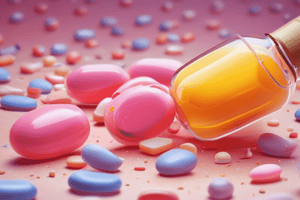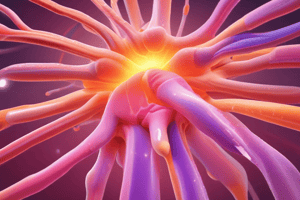Podcast
Questions and Answers
What is the primary goal of colchicine in the treatment of gout?
What is the primary goal of colchicine in the treatment of gout?
- To provide rapid relief from acute gouty attacks (correct)
- To enhance plasma protein binding
- To increase serum urate levels
- To diagnose chronic osteoarthritis
How does colchicine exert its anti-inflammatory effects?
How does colchicine exert its anti-inflammatory effects?
- By enhancing neutrophil chemotaxis
- By inhibiting phospholipase A2 (correct)
- By stimulating prostaglandin production
- By blocking serum urate absorption
What is the recommended prophylactic dose of colchicine for patients with normal renal function?
What is the recommended prophylactic dose of colchicine for patients with normal renal function?
- 0.5 mg three times a day
- 1.0 mg once daily
- 1.2 mg daily
- 0.6 mg once or twice daily (correct)
Which of the following is NOT an indication for colchicine therapy?
Which of the following is NOT an indication for colchicine therapy?
What is the half-life of colchicine after oral administration?
What is the half-life of colchicine after oral administration?
Which mechanism contributes to colchicine's ability to prevent inflammation?
Which mechanism contributes to colchicine's ability to prevent inflammation?
In which patient condition should colchicine be used with caution?
In which patient condition should colchicine be used with caution?
What role does colchicine play when initiating hypouricemic therapy?
What role does colchicine play when initiating hypouricemic therapy?
In which of the following conditions should the dose of colchicine be reduced or avoided?
In which of the following conditions should the dose of colchicine be reduced or avoided?
Which of the following medications is known as a CYP 3A4 inhibitor and poses a risk when used with colchicine?
Which of the following medications is known as a CYP 3A4 inhibitor and poses a risk when used with colchicine?
What is a common adverse effect associated with chronic use of colchicine?
What is a common adverse effect associated with chronic use of colchicine?
Which of the following therapies can safely be used in conjunction with allopurinol for patients with severe tophaceous gout?
Which of the following therapies can safely be used in conjunction with allopurinol for patients with severe tophaceous gout?
What is one of the effects of colchicine toxicity that is associated with renal insufficiency?
What is one of the effects of colchicine toxicity that is associated with renal insufficiency?
What should be done to minimize the risk of acute gouty attacks when initiating uric acid-lowering therapy?
What should be done to minimize the risk of acute gouty attacks when initiating uric acid-lowering therapy?
Which of the following describes the purpose of xanthine oxidase inhibitors like allopurinol?
Which of the following describes the purpose of xanthine oxidase inhibitors like allopurinol?
Which side effect related to colchicine can affect fertility?
Which side effect related to colchicine can affect fertility?
What is the primary mechanism by which uricosuric drugs increase urinary excretion of uric acid?
What is the primary mechanism by which uricosuric drugs increase urinary excretion of uric acid?
Which condition is most likely an indication for uricosuric therapy?
Which condition is most likely an indication for uricosuric therapy?
How does urine alkalinization affect uricosuric therapy?
How does urine alkalinization affect uricosuric therapy?
Which of the following medications can be safely used in conjunction with uricosuric therapy?
Which of the following medications can be safely used in conjunction with uricosuric therapy?
What is a significant consideration when prescribing losartan for patients with gout?
What is a significant consideration when prescribing losartan for patients with gout?
Which of the following is a notable pharmacokinetic property of febuxostat?
Which of the following is a notable pharmacokinetic property of febuxostat?
What level of urinary uric acid is indicative of underexcretion in patients with gout?
What level of urinary uric acid is indicative of underexcretion in patients with gout?
Which uricosuric drug acts primarily by inhibiting tubular reabsorption of urate?
Which uricosuric drug acts primarily by inhibiting tubular reabsorption of urate?
Flashcards
Hypouricemic Agents
Hypouricemic Agents
A group of drugs used to reduce uric acid levels in the blood, aiming to prevent gout attacks and complications.
Colchicine
Colchicine
Colchicine is a natural compound derived from a specific plant, used for centuries to manage gout attacks and joint pain.
Mechanism of Action of Colchicine
Mechanism of Action of Colchicine
Colchicine primarily works by reducing inflammation. It blocks the movement of white blood cells that contribute to inflammation.
Pharmacokinetics of Colchicine
Pharmacokinetics of Colchicine
Signup and view all the flashcards
Indications for Colchicine
Indications for Colchicine
Signup and view all the flashcards
Colchicine Dosages
Colchicine Dosages
Signup and view all the flashcards
Goal of Gout Treatment: Acute Attack
Goal of Gout Treatment: Acute Attack
Signup and view all the flashcards
Goal of Gout Treatment: Long-term
Goal of Gout Treatment: Long-term
Signup and view all the flashcards
Uricosuric therapy
Uricosuric therapy
Signup and view all the flashcards
Uricosuric drugs
Uricosuric drugs
Signup and view all the flashcards
Mechanism of action of Uricosuric drugs
Mechanism of action of Uricosuric drugs
Signup and view all the flashcards
Xanthine oxidase inhibitors
Xanthine oxidase inhibitors
Signup and view all the flashcards
Febuxostat
Febuxostat
Signup and view all the flashcards
Allopurinol
Allopurinol
Signup and view all the flashcards
Hypertension in Gout Patients
Hypertension in Gout Patients
Signup and view all the flashcards
Indications of uricosuric therapy
Indications of uricosuric therapy
Signup and view all the flashcards
What is colchicine?
What is colchicine?
Signup and view all the flashcards
When should colchicine dose be reduced?
When should colchicine dose be reduced?
Signup and view all the flashcards
Why avoid colchicine in cyclosporine users?
Why avoid colchicine in cyclosporine users?
Signup and view all the flashcards
What medicine is less risky than cyclosporine with colchicine?
What medicine is less risky than cyclosporine with colchicine?
Signup and view all the flashcards
What influences colchicine's side effects?
What influences colchicine's side effects?
Signup and view all the flashcards
What are the potential side effects and complications of colchicine?
What are the potential side effects and complications of colchicine?
Signup and view all the flashcards
What are uricosurics and how do they work?
What are uricosurics and how do they work?
Signup and view all the flashcards
How do xanthine oxidase inhibitors lower uric acid?
How do xanthine oxidase inhibitors lower uric acid?
Signup and view all the flashcards
Study Notes
Hypouricemic Agents and Colchicine
- Hypouricemic agents are drugs used to lower serum urate levels.
- Colchicine comes from the Colchicum autumnale plant.
- Colchicine has been used for centuries to treat acute gout and joint pain.
- The clinical response to colchicine was initially a diagnostic tool for gout.
Sites of Action for Drugs
- Drugs used to lower serum urate levels work at various points in the purine metabolism pathway.
- Purines are metabolized to hypoxanthine and xanthine, then further to uric acid.
- Xanthine oxidase inhibitors prevent uric acid production.
- Uricosurics increase renal excretion of uric acid.
- Uricase converts uric acid to allantoin, which is more readily excreted.
- Tissue deposition and inflammation (tophi formation) from uric acid are also targeted.
- Drugs can also inhibit processes such as phagocytosis of uric acid crystals.
Goals of Gout Treatment
- Acute gout attacks require rapid pain relief and restoration of joint function (NSAIDS, corticosteroids, colchicine are often used).
- Long-term prevention of recurrent attacks and prevention of destructive arthropathy, tophi formation, and nephrolithiasis is achieved with hypouricemic therapy.
Colchicine Mechanism of Action
- Colchicine acts as an anti-inflammatory agent.
- It interferes with neutrophil functions, including chemotaxis and phagocytosis.
- Colchicine inhibits phospholipase A2, which lowers inflammatory prostaglandins and leukotrienes.
Colchicine Pharmacokinetics
- Colchicine is not protein-bound.
- It's highly lipid-soluble and readily crosses tissues.
- The half-life is about 4 hours after oral administration.
- Colchicine can be detected in neutrophils for up to 10 days after a single dose.
- It's primarily metabolized in the liver and excreted in bile with about 20% excreted unchanged in urine.
Colchicine Indications
- Treatment of acute gouty attacks.
- Prophylaxis against future attacks, especially when initiating hypouricemic therapy.
- Treatment of other inflammatory arthropathies (e.g., familial Mediterranean fever, pseudogout, acute sarcoid arthritis).
Colchicine Dosages
- Colchicine is available as 0.5-0.6 mg tablets.
- Prophylactic dose: 0.6 mg once or twice daily (reduces frequency in up to 85% of patients with normal renal function), usually until symptoms are resolved.
- Acute attacks: 1.2 mg initial dose, followed by 0.6 mg one hour later; provides similar efficacy to higher dose regimens with less toxicity.
Colchicine Precautions
- Reduce dose or avoid in patients with severe renal or hepatic insufficiency.
- Avoid in patients taking CYP3A4 inhibitors.
- Cautious use in patients on cyclosporine (risk of neuromyopathy). Tacrolimus is less problematic.
Colchicine Toxicity
- Most side effects are dose and duration-related and worsen with chronic use and renal insufficiency.
- No antidotes for overdose, and hemodialysis is ineffective.
- Potential side effects include GI effects, bone marrow suppression, neuromyopathy, alopecia, and reproductive issues.
Uric Acid-Lowering Therapy (Antihyperuricemic)
- Uricosurics (probenecid): enhance renal excretion of uric acid.
- Xanthine oxidase inhibitors (allopurinol, febuxostat): inhibit uric acid synthesis.
- Uricase (pegloticase): converts uric acid to allantoin.
Uric Acid-Lowering Therapy (Initiation)
- Should be initiated only after an acute gout attack has resolved.
- The risk of recurrence is minimized by gradual increases and prophylaxis using colchicine, NSAIDs, or low-dose prednisone.
Uricosuric Therapy (Mechanism)
- Inhibit URAT1 and GLUT9 to decrease tubular reabsorption of uric acid.
- Works best with increased urine alkalinity (pH >6.0) and flow (>1500 mL/day).
Uricosuric Therapy (Probenecid)
- Generally well-tolerated (>90% of patients).
- Should not be stopped during an acute gout attack.
- Half-life: 6-12 hours, hepatically metabolized.
- Forms: 500 mg tablets, sometimes combined with 0.5 mg colchicine.
- Dosage: Initial dose 500 mg twice daily, gradually increased to 3 g daily (average 1 g/day in divided doses).
Uricosuric Therapy (Drug Interactions)
- Probenecid prolongs the half-life of penicillin, dapsone, methotrexate, indomethacin, and others by decreasing their renal excretion.
- It also prolongs heparin metabolism.
Xanthine Oxidase Inhibitors (Indications)
- Urate overproduction (uric acid >800 mg/24 hr urine).
- Nephrolithiasis
- Renal insufficiency (CrCl < 50 mL/min).
- Tophi (may take months to resolve).
- Failure or intolerance of uricosuric agents.
- Other indications include hyperuricemia with nephrolithiasis, tumor lysis syndrome prophylaxis, HPRT deficiency (Lesch-Nyhan syndrome), myeloproliferative disorders, serum urate >12.0 mg/dL, or 24-hour urine uric acid >1100 mg.
Xanthine Oxidase Inhibitors (Febuxostat/Allopurinol - Mechanism/PK)
- Febuxostat/Allopurinol mechanism of action involves inhibiting xanthine oxidase which leads to more xanthine and hypoxanthine.
- Febuxostat is absorbed in the GIT at 50%, metabolized by the liver, and excreted through the liver and kidneys.
- Allopurinol is metabolized to oxipurinol by xanthine oxidase and has a long half-life (14-28 hrs.).
Xanthine Oxidase Inhibitors (Febuxostat/Allopurinol- Dosages/Toxicity)
- Febuxostat is given at 40-mg/80-mg once daily and can be increased to 80-120mg/day.
- Allopurinol is given at 100-mg/300-mg daily and can be increased to 4 mg/kg.
- Allopurinol side effects include a maculopapular rash (3% risk), diarrhea, abnormal liver function enzymes.
- Allopurinol hypersensitivity syndrome (AHS) is less common but can be severe, presenting with skin rash, fever, eosinophilia, hepatic necrosis, leukocytosis, and worsening renal function within 2-4 weeks of starting treatment. AHS occurs in 0.1% to 0.4% of patients. Use of desensitization protocols is no longer recommended.
Pegloticase Mechanism/Administration/Precautions
- Pegloticase is a recombinant mammalian uricase attached to polyethylene glycol (PEG).
- It's used for severe or refractory gout when other treatments fail to lower serum uric acid to <6 mg/dL.
- Given as a 2-hour IV infusion of 8 mg every 2 weeks
- All patients must be screened for G6PD deficiency before use. Avoid in patients with low G6PD activity.
- Monitor serum uric acid levels before each infusion to assess efficacy and to avoid antibody-mediated reactions, including anaphylaxis.
- Initiate prophylaxis (colchicine, NSAIDs, or prednisone) one week before pegloticase initiation.
Renal Handling of Uric Acid
- Uric acid is excreted primarily (66%) through the kidneys via glomerular filtration, proximal tubule reabsorption, and tubular secretion and reabsorption.
- In renal failure, GI excretion increases.
Studying That Suits You
Use AI to generate personalized quizzes and flashcards to suit your learning preferences.




